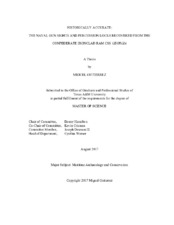| dc.description.abstract | Construction for a 19th-century Confederate ironclad ram known as CSS Georgia began in March 1862 after the Ladies Gunboat Association of Savannah, Georgia raised the necessary funds. However, Georgia never saw action and spent most of its career moored on the Savannah River. The Confederates intentionally sunk Georgia as General William T. Sherman’s troops approached Savannah in 1864 to prevent its capture by Union forces. It spent the next 150 years at the bottom of the channel.
The U.S. Army Corps of Engineers Savannah District, in partnership with Panamerican Consultants, Inc., the Conservation Research Laboratory (CRL) at Texas A&M University, and the U.S. Naval History and Heritage Command, organized the recovery of thousands of artifacts and sent many of them to the CRL for subsequent conservation. This vast collection of artifacts includes a set of brass naval instruments known as gun sights. Their use enhanced the accuracy of guns during engagements at sea. Additionally, Georgia yielded brass percussion locks that facilitated the instantaneous discharge of naval guns. They represent one of the largest archaeologically recovered collections of naval gun sights and percussion locks from this era.
A brief historical survey of the introduction of guns at sea places the naval gun sights and percussion locks within a broader context. Between the 16th-century and the Civil War, the world’s navies placed different kinds of sighting mechanisms on guns and these continued to improve until their culmination in the form of the complex naval gun sights and percussion locks recovered from Georgia. The design and use of the Georgia gun sights reflects an understanding of the physical properties of a projectile in flight. The evolution of naval gunnery, sighting mechanisms used on guns, and the scientific understanding of the physical properties of a projectile in flight all form a strong basis from which a detailed analysis of the naval gun sights and percussion locks under study can be made. This research sheds more light on aspects of naval gunnery during the Civil War. | en |


